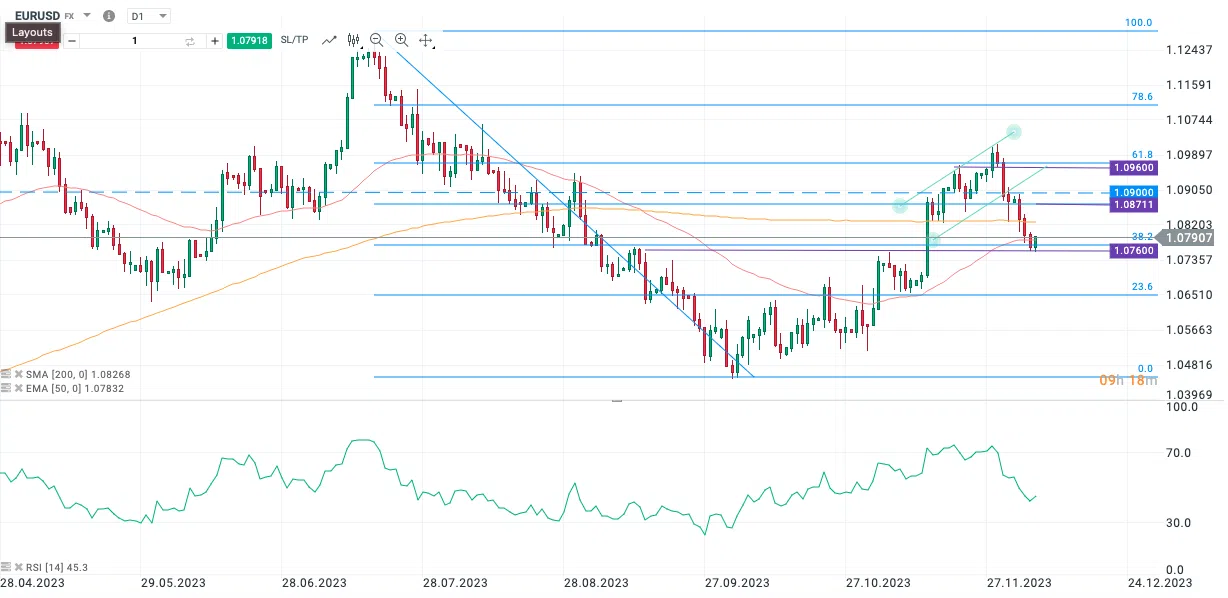-
Best Forex Brokers
Our top-rated Forex brokers
-
NGN Trading Accounts
Save on conversion fees
-
Brokers for Beginners
Start trading here
-
Forex Demo Accounts
Learn to trade with no risk
-
ECN Brokers
Trade with Direct Market Access
-
No-Deposit Bonuses
Live trading with no deposit
-
High Leverage Brokers
Extend your buying power
-
Lowest Spreads Brokers
Tight spreads and low commissions
-
Islamic Account Brokers
Best accounts for Muslim traders
-
Market Maker Brokers
Fixed spreads & instant execution
-
MetaTrader 4 Brokers
The top MT4 brokers in Nigeria
-
MetaTrader 5 Brokers
The top MT5 brokers in Nigeria
-
TradingView Brokers
The top TradingView brokers
-
cTrader Brokers
The top cTrader brokers in Nigeria
-
Forex Trading Apps
Trade on the go from your phone
-
Copy Trading Brokers
Copy professional traders
-
All Trading Platforms
Find a platform that works for you
The EUR/USD continued its decline today, Thursday 7th December, capping a poor week for the common currency. Freshly released data showed that the Q3 GDP came in lower than expected, with YoY GDP narrowly avoiding a contraction to remain flat at 0% – versus market expectations of 0.1% growth.
There has been a slowdown in manufacturing and services across Europe, though the collapse of the German manufacturing sector has hit EU growth prospects particularly hard.

The latest data has done nothing to change market expectations of a drastic cut in EU interest rates in 2024. While markets also expect a series of rate cuts in the USA, pricing in at least 5 cuts in 2024, they are betting that the EU will have to cut rates sooner to avoid a recession. As long as the market expects a sharper slowdown in the EU than in the US, the pressure on the EUR will remain.
As an aside, there has been growing consternation that market expectations and central bank policy are drifting apart. I mentioned last week that the OECD predicted that the European Central Bank would hold rates steady throughout 2024 and I dismissed the idea as fanciful. I still believe that this forecast is unlikely, especially with EU economic growth stagnant and business sentiment still recovering. But I am less sure that we will see the sharp cut in rates that traders are expecting.I
Traders in swaps markets are pricing in a high likelihood of the first cut in the ECB’s deposit rate of 4 per cent by March, and close to six quarter-point cuts by the end of the year, a steep increase from three or four cuts priced in late November. But Christine Lagarde, President of the ECB, is on the record stating rate cuts are not expected for the next “couple of quarters”.
On the other side of the Atlantic, Jay Powell, Chairman of the Federal Reserve, has made it abundantly clear in his recent remarks that market expectations are divorced from policymaker intentions, saying “it was premature to conclude with any confidence that we have achieved a sufficiently restrictive stance, or to speculate on when policy might ease”. He also reminded markets that he and his colleagues on the Fed’s policy-setting committee “are prepared to tighten policy further if it becomes appropriate to do so”.
Markets have also largely ignored his comments, with the futures markets pointing to a near-50% probability the Fed will cut rates in March and an 80% chance it will act in May.
Expectations of imminent lower rates have led to a splurge in corporate debt issuance, with corporate borrowers in the US and Europe issuing $246bn worth of investment-grade and junk bonds in November alone — 57% more than October’s total, and $16bn higher than the average figure for the first 10 months of the year. This matters, as financial loosening on this scale only makes it harder for central banks to control inflation. Ironically, it only increases the chances of central banks holding rates higher for longer.
So, who is going to blink first here, the markets or the central banks? Something is going to have to give, and the danger is that central banks will be forced into a decision they don’t want to make to protect markets. Equally dangerous is that markets are wrongfooted by policy and investors are exposed to painful losses on their debt holdings.
In the short-term, we can expect continued weakness in the EUR – though if the NFP figures released tomorrow show a dramatic slowdown in the US economy this narrative could easily turn. Markets are uncertain, and possibly on very shaky ground when it comes to monetary policy, which makes for fragility and increased risk.
Technical Analysis
The EUR/USD continues to slide, having been mostly bearish since it turned on 29 November 2023, following lower-than-expected inflation in the Euro Area. The pair broke below the channel of 14 November – 1 December at the 1.0900 level, resting temporarily at the 50% Fibonacci Retracement level of the 2023 downtrend at 1.08711, and plummeted past the 200-day MA (orange). The fall continued below the 50-day EMA (pink) yesterday, towards the 38.2% Fibonacci support level of 1.07740, where it now hovers, anticipating the NFP release tomorrow.

EUR/USD Daily Chart by XTB, prepared by Alison Heyerdahl
From a purely technical standpoint, the EUR/USD still has the potential for further downside moves, with the RSI having crossed below 50%, but not yet in oversold territory. Immediate resistance is at the 1.0800 psychological handle, which if breached, could attract buyers, while on the downside, an extended slide toward the 1.0700 psychological handle could occur if the 1.0760 support fails.
































